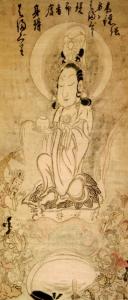
At the beginning of 2018, I began a year-long focus on Hakuin’s teaching, specifically, Norman Waddell’s newly translated Complete Poison Blossoms from a Thicket of Thorn: The Zen Records of Hakuin Zenji. In this blog post, I want to share the most important thing that about Hakuin’s Zen.
First, a little background. Hakuin (1686 – 1768) was a Japanese monk in the Rinzai tradition. Widely regarded as an exceptional artist, story teller, and fierce Zen master, he and his successors kept alive the Rinzai lineage in Japan, and largely through the efforts of the Sōtō monk, Harada Daiun Sogaku, are the source of much of the kōan introspection practiced outside of Japan today. For more on Hakuin, click here.
Some Cool Stuff About Hakuin That Aren’t Most Important
One of Hakuin’s outstanding gifts to us is the raw openness with which he showed up. He repeatedly took the Japanese custom of self-disparagement beyond normal limits and into fresh and sometimes hysterical extremes. For Hakuin, the bodhisattva of compassion, Kannon, as a lowly clam crossing over from the shore of suffering to the nirvana, was it. He inspires us to be exactly who we are. For more on this, see the image above and click here.
Furthermore, Hakuin penetrated the depths of the buddhadharma and shared his insights, usually through a vividly immanent expression of old Zen kōans, but also through reinvigorating the study and practice of the sutras. He also created new kōans like, “What is the sound of the single hand?” “East wall strikes west wall,” and “What is the color of the wind?” Indeed, Hakuin was a kōan master the likes of whom are seen only rarely on this little blue dumpling planet.
Hakuin also emphasized the importance of kenshō (awakening) and also the essential importance of continued post-kenshō training, vigorously moving through all the barriers and nasty briars left by our dharma ancestors. For more on this, click here.
Hakuin’s Definitive Awakening and the Most Important Thing
But none of these are his most important contribution to us. Hakuin’s most important contribution came from his own definitive awakening. For this, I’ll quote Waddell at some length:
“The religious quest that had been the single focus of his life for more than a quarter century finally came to an end one night in his forty-first year. He was in his chambers at Shōin-ji reading the Lotus Sutra, the very same chapter, the one on parables, he had dismissed years before as ‘a mere collection of simple tales about cause and effect.’
“In that chapter, the Buddha reveals to his disciple Shariputra the true nature of the Mahayana Bodhisattva, whose own enlightenment is but the first step in his career of assisting others to attain theirs. This is identical to the teaching Shōju had tried to drive home to Hakuin years before. Like Shariputra, Hakuin had erroneously regarded his original realization as full and perfect enlightenment, and he would have been unable to proceed beyond that realization without the timely assistance of a genuine teacher.
“As Hakuin read, the sound of a cricket churring at the foundation stones of the temple reached his ears; at that instant, he crossed the threshold into great enlightenment. The accumulated doubts and uncertainties of forty years suddenly ceased to exist. The reason why the Lotus Sutra was regarded as supreme among all the Buddha’s preachings was revealed to him ‘with blinding clarity.’ He found teardrops ‘cascading down his face like strings of beads—they poured out like beans from a ruptured sack.’” (1)
Simply put, the point of dharma practice, of a human life well-lived, is to awaken thoroughly enough to help others awaken. Hakuin’s open-hearted presentation, his art, his kōan offerings, his emphasis on kenshō, are all just about this – actualizing the bodhisattva vow. A quick search of the Complete Poison Blossoms finds Hakuin returning to this theme 80 times (more or less).
Spurring Forward the Wheel of the Four Great Universal Vows
Here is verse where Hakuin lays it out most clearly:
“Even if you are able to enter through the gates into nonduality,
If you lack the Bodhi-mind you’ll end up under Mara’s sway.
Anyone who wants to achieve complete mastery of the Dharma
Has to spur forward the wheel of the four great universal vows.” (2)
Yes! Cutting through all of the secondary and tertiary motivations for Zen practice (love of zazen; psychological, spiritual, physical healing; the subtlety and depth of the kōan literature; fluidity in life and death; mastering expression of the great matter; etc.), Hakuin returns, simply and finally, to Great Vehicle Awakening Truth (aka, Mahayana Buddhism), encouraging us through his example, to put our shoulders to the wheel of the four great universal vows. (3)
Hakuin’s Zen offers a path where fulfilling the four great universal vows is an actual possibility, clearly defined, not just vague buddha-dogma. I find the clarity of this focus utterly vivifying, cutting through the self-centered focus of our present culture and dharma scene.
It’s really about this great love. This great love isn’t a mushy, idealistic, romantic love, but a tough and messy love that is made alive through cultivating wholehearted verification, and then showing up in this world to help others realize this very mind is buddha.
That is it.
(1) Wild Ivy: The Spiritual Autobiography of Zen Master Hakuin, Hakuin Zenji & Norman Waddell, (Kindle Locations 410-413).
(2) Complete Poison Blossoms from a Thicket of Thorn, Hakuin Zenji & Norman Waddell, p. 138.
(3) An interpretive version: “The many beings are numberless; Vowing to carry them across.
Greed, anger, and ignorance rise endlessly; Vowing to cut off the mind road.
Dharma gates are countless; Vowing to wake to them all.
Buddha’s Way is all embracing; Vowing to follow through.”
Dōshō Port began practicing Zen in 1977 and now co-teaches with his wife, Tetsugan Zummach Sensei, with the Vine of Obstacles: Online Support for Zen Training, an internet-based Zen community. Dōshō received dharma transmission from Dainin Katagiri Rōshi and inka shōmei from James Myōun Ford Rōshi in the Harada-Yasutani lineage. Dōshō’s translation and commentary on The Record of Empty Hall: One Hundred Classic Koans, is now available (Shambhala). He is also the author of Keep Me In Your Heart a While: The Haunting Zen of Dainin Katagiri. Click here to support the teaching practice of Dōshō Rōshi at Patreon.












